Friday, September 27, 2013
Replacing a Misplaced Bead in your Peyote Stitch Pattern
Sunday, May 26, 2013
Make those Odd Count Peyote Stitch turns easy!
The first is theone I prefer, mainly because it does not give you a tighter edge on the odd side.
The second will give you one edge that is tighter so you have to be careful not to pull too tight.
Here is the first:
When you get to the end of the odd count turn, do not pick up the last bead but instead go through the end bead below your current row.
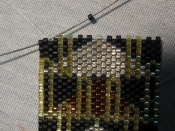
Then pick up your last bead of the current row and go through the beas below again.
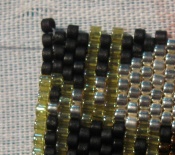
Go back through the bead you just added to put you in the correct position to begin the next row.
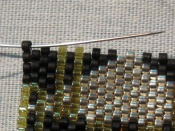
For the second method, gp through the last up bead in the current row
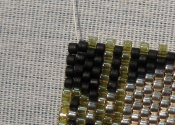 then pick up your last
bead of the row. Take the needle under the thread on the edge .
then pick up your last
bead of the row. Take the needle under the thread on the edge .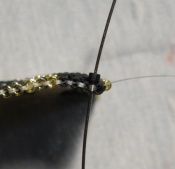 Now go bacj through the
bead you just added to put you in the position for the following row.
Now go bacj through the
bead you just added to put you in the position for the following row. 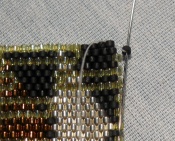 Pull snug, but not too
tight
Pull snug, but not too
tight 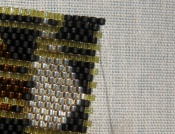
Make sure to visit my website Divella Delights for more tips and tricks; beautiful hand-created jewelry and hats!
Wednesday, July 21, 2010
Beading Tutorial Woes
While I have been beading for a while there are times when I am just uninspired and want to learn a new technique so I cruise around, usually on Esty looking for something that catches my eye. The goal for me is to learn a new technique that I can later incorporate into my own designs. Perhaps a new stitch or a different way of adding a clasp.
When I first began beading several years ago I purchased a lot of books, DVDs and Tutorials because I was working full time and did not have the time for classes. I live a distance away from any classes that were begin offered.
What I have found is that until you are quite experienced you might want to invest in the time and money to take a class.
While the photos on the finished product look delicious and are described as very easy, I have found that it usually is not. I have recently purchased some very good beading tutorials as you have seen in my last blog and I highly recommend this artisan. A few days later I decided to buy this one

It is my opinion that if you cannot properly finish a piece of jewelry making it becomes a waste of time and money. There is a large website dedicated to beading tutorials that rarely gives you complete instructions…although on most of them they do tell you that.
In order to help you in your search I have a few questions you should ask BEFORE you buy beading tutorials.
What level of experience should I have to complete this?
What materials and tools will it require?
Are the instructions complete from stringing the first bead to being able to wear it?
Is the seller available for questions should you have any?
If there is a question in your mind while you are looking at a tutorial...ASK!
The key when it comes to tutorials you are paying for is to ask questions BEFORE you buy it.
I will have more tutorial tips and questions coming up soon as well as some new really good beading tutorial buys!
Monday, January 18, 2010
Free Beading Patterns, Tips and Tricks
I will be giving you some free wonderful designs, tips and tricks I use all free of charge!
I plan to photograph my designs as I work through them so along with the pattern you will have photos to make it easier. This process takes a little time so be patient with me. Along the way if you find some tips I could use, please by all means chime in!
Let’s have some fun this year creating some beautiful jewelry and fiber creations!
See you soon with the first of many!
I'll start of with a little tip since I need no photo for it.
If you use a Nymo type thread I am sure you already stretch it and condition it with Beeswax or some other thread conditioner. Nymo and similar threads stretch over time and you do not want your lovely creations to get sloppy over time. You stretch it simply by pulling it taught and then just a little more. After I do that I have found that I get much fewer tangles if I simply snip off about 2 inches on each end. This way those little ends that you can't stretch don't coil around my work making knots and tangles.
Thursday, September 10, 2009
Beading Studio on a Shoestring
I was always digging through bins and drawers to find my pearls and gems and I never really knew what I had or needed. I put the bulletin boards up in my studio and started pinning my treasures in small plastic bags, many of which are the bags they came in. I also have a box for retired bags so I always have plenty on hand. Now in addition to being able to see what I have, I feel much more inspired and I can just go around the room and pick what I want off the board. In addition to that now that those are on the walls I have more space on the shelves.
My seed beads are on shelves by size and color so they are also in plain site.

I use the large plastic salad containers to organize my thread and lightweight stringing material and tin cans to hold tubes of beads, again organized by size and color.

The drawers that used to hold my beads now hold fibers and other stringing materials (mostly for macramé) keeping them safe from the sun and lighting that can fade them.
I hope someday to be able to get some sort of sliding wall to put them on so I can close them when I am not using them to keep them from the light and be a little more attractive but for now this works very well!
Cold weather, Hot flashes and Beading
Being comfortable and hassle free is important to me when I am working. I spend much of the day in my studio either working or learning new techniques and it is difficult to regulate my internal thermometer as I go through the trials of menopause.
As the temperature dips and we enter the cold weather season I am reminded of a handy little tip that I came up with last year while trying to bead with a flannel shirt on. The thread likes to grab the buttons and causes problems for me. I like to keep it a little cool in my studio but sometimes it gets just cool enough that I need another layer but not enough to turn up the heat.
Now, I could wear a sweater or sweatshirt but this poses a problem for me which a few of you will understand. There are times when I have to quickly take off the outer layer. All of you who are there, or have been know how hard it is to regulate our body temperature and how quickly it can change! I got angry one day and cut off all the buttons on one of my shirts and this works very well!
Now I keep this shirt in my studio to wear when there is a chill in the air. I can take it off quickly when my body turns up the heat and put it back on when I return to "normal" several minutes later. I actually have 2 shirts I have done this to, a flannel and a regular cotton denim shirt for times when I don’t need quite the warmth of a flannel. I just fold the sleeves up and I can continue beading without the interruptions.











